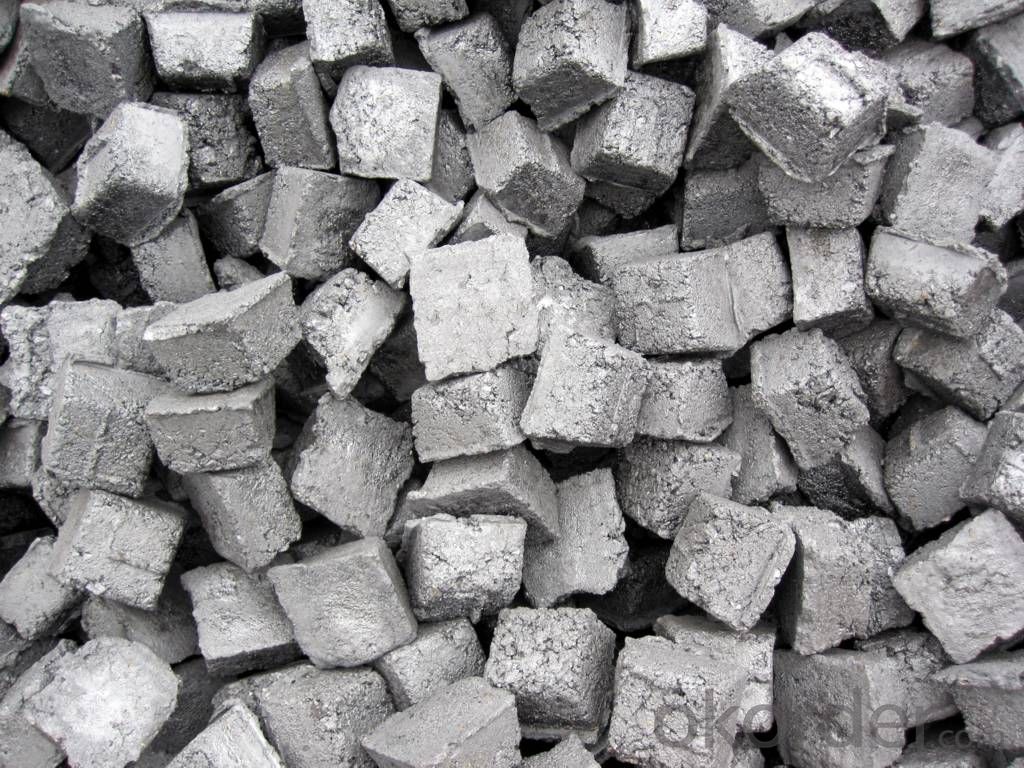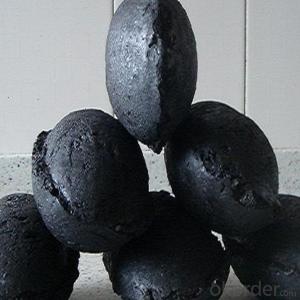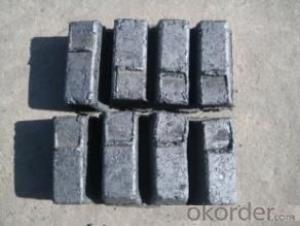Carbon Electrode Paste with low Ash 4% max
- Loading Port:
- Lianyungang
- Payment Terms:
- TT OR LC
- Min Order Qty:
- 20 m.t.
- Supply Capability:
- 800 m.t./month
OKorder Service Pledge
OKorder Financial Service
You Might Also Like
Spcifications
1:carbon eletrode paste
2:for ferroalloy,calcium carbide manufacture
3:HS 3801300000,YB/T5212-1996,ISO9001:2008
Product Description
Carbon Electrode Paste is a self-baking electrode used in submerged arc furnaces for delivering power to the charge mix. Electrode Paste is added to the top of the electrode column in either cylindrical or briquette form. As the paste moves down the electrode column the temperature increase causes the paste to melt and subsequently bake forming a block of electrically conductive carbon. Electrode Paste is essentially a mix of Electrically Calcined Anthracite (ECA) or Calcined Petroleum Coke (CPC) with Coal Tar Pitch.
Graphite/Carbon Electrode Paste Specification:
| PARAMETER UNIT GUARANTEE VALUE | ||||||
| Ash.( % ) | 4.0 max | 5.0 max | 6.0 max | 7.0 max | 9.0 max | 11.0 max |
| V.M (%) | 12.0-15.5 | 12.0-15.5 | 12.0-15.5 | 9.5-13.5 | 11.5-15.5 | 11.5-15.5 |
| Compress Strength. | 18.0 min | 17.0 min | 15.7 min | 19.6 min | 19.6 min | 19.6 min |
| Specific Resistance | 65 max | 68 max | 75 max | 80 max | 90 max | 90 max |
| Bulk Density | 1.38 min | 1.38 min | 1.38 min | 1.38 min | 1.38 min | 1.38 min |
Picture:


- Q:How does carbon dioxide affect fuel efficiency?
- Fuel efficiency in vehicles is primarily influenced by factors such as engine efficiency, weight, aerodynamics, and driving conditions. Carbon dioxide, on the other hand, is a byproduct of burning fossil fuels, commonly used as vehicle fuel. When fossil fuels are burned, carbon dioxide is released into the atmosphere, contributing to the greenhouse effect and climate change. However, it is important to note that the increased concentration of carbon dioxide in the atmosphere does not directly impact fuel efficiency. Despite this, reducing carbon dioxide emissions remains crucial for mitigating climate change and promoting a sustainable future.
- Q:What is the basic principle of carbon fourteen detection?
- Carbon fourteenCarbon fourteen, a radioactive isotope of carbon, was first discovered in 1940. It is produced by hitting twelve carbon atoms in the air through cosmic rays. Its half-life is about 5730 years, the decay is beta decay, and the carbon 14 atoms are converted to nitrogen atoms. Since its half-life is 5730 years, and carbon is one of the elements of organic matter, we can infer its age by the 14 component of the residual carbon in the dying organism. When living in the biological, because need to breathe, the carbon content of 14 in its body is about the same, the organisms die will stop breathing, at this time the carbon 14 in the body began to decrease. Since the proportion of carbon isotopes in nature is always stable, one can estimate the approximate age of an object by measuring its carbon 14 content. This method is called carbon dating. Other commonly used methods include potassium argon measurements, potassium argon measurements, thermoluminescence measurements, and others;
- Q:Stability, primary carbon, two carbon, three carbon, four carbon
- (2) due to free radicals generated in the outer layer of only 7 electrons, eight corner structure did not reach saturation, so it is an electron deficient species, while methyl (or alkyl) is an electron donor groups can alleviate the lack of this kind of electron, so that the stable free radicals, free radicals and carbon alkyl substituents on the more, the more stable free radical. And more stable, more easy to generate.
- Q:How does carbon impact the prevalence of cyclones?
- Carbon emissions and the subsequent increase in atmospheric carbon dioxide levels have a significant impact on the prevalence of cyclones. Cyclones, also known as hurricanes or typhoons, are powerful and destructive weather phenomena that form over warm ocean waters. The increased carbon in the atmosphere, primarily due to human activities such as burning fossil fuels, leads to global warming and alters the climate patterns. Warmer ocean temperatures caused by carbon emissions provide the necessary fuel for cyclones to form and intensify. As carbon dioxide traps heat in the atmosphere, it warms the surface of the oceans, creating a favorable environment for cyclone development. The warmer the ocean waters, the more energy is available for cyclones to grow and become more destructive. Additionally, carbon emissions contribute to the changing climate patterns, leading to shifts in atmospheric circulation patterns. These changes can influence the frequency, intensity, and track of cyclones. While it is difficult to attribute individual cyclones to carbon emissions, scientific studies show that the overall increase in carbon dioxide levels is contributing to a greater number of severe cyclones in certain regions. Furthermore, the rising sea levels associated with global warming and carbon emissions can exacerbate the impact of cyclones. Higher sea levels lead to increased storm surge, which is the abnormal rise in water level during a cyclone. This storm surge can cause devastating flooding in coastal areas and result in significant damage to infrastructure and loss of life. In conclusion, carbon emissions have a profound impact on the prevalence of cyclones. The increased atmospheric carbon dioxide levels contribute to warmer ocean temperatures, creating a more favorable environment for cyclone formation and intensification. Changes in climate patterns due to carbon emissions also affect the frequency and track of cyclones. Additionally, rising sea levels associated with global warming can worsen the impact of cyclones through increased storm surge. It is crucial for society to address carbon emissions and work towards sustainable solutions to mitigate the impacts of cyclones and other severe weather events.
- Q:What is the effect of carbon equivalent on welding?
- The carbon equivalent of less than 0.4%, good weldability; in 0.4~0.6%, poor weldability, welding preheating and other measures to prevent cracks; more than 0.6 words, when welding needs higher temperature and strict technical measures! PS: carbon equivalent =C+Mn/6+ (Ni+Cu) /15+ (Cr+Mo+V) /5, Q235 carbon content in 0.14%~0.22% between, widely used by the company seems to be Q235B, carbon content between 0.12~0.20%
- Q:How many electrons does carbon have?
- There are 6 electrons in carbon.
- Q:How do plants and trees absorb carbon dioxide?
- Plants and trees absorb carbon dioxide through a process called photosynthesis. Photosynthesis is the process by which plants convert sunlight, water, and carbon dioxide into glucose (sugar) and oxygen. The process takes place in the chloroplasts, which are specialized structures within the plant cells. During photosynthesis, plants absorb carbon dioxide from the atmosphere through tiny pores on their leaves called stomata. The carbon dioxide enters the plant's cells and travels to the chloroplasts. Inside the chloroplasts, energy from sunlight is used to convert the carbon dioxide and water into glucose and oxygen. The glucose produced through photosynthesis is used by the plant as a source of energy for growth, reproduction, and other metabolic activities. Some of the glucose is stored in the plant as starch, while the rest is used to produce other essential compounds. The oxygen produced during photosynthesis is released back into the atmosphere through the stomata. This oxygen is vital for the survival of animals, including humans, as it is necessary for respiration. Overall, plants and trees play a crucial role in absorbing carbon dioxide from the atmosphere through photosynthesis. They act as natural carbon sinks, helping to regulate the levels of this greenhouse gas and mitigate the effects of climate change.
- Q:What do you stand for?Tar, smoke, nicotine, and carbon monoxide. What do you mean? What's the size of the smoke, or the size of the smoke? What's the connection? Smoking is harmful, so how do you choose to smoke smaller cigarettes?
- These three values referred to as physical and chemical indicators, my understanding is this: the Tar Nicotine tar is representative of nicotine. The carbon monoxide is simply to give the environmental protection department and health department occasional children get. Like the automobile exhaust mean.
- Q:How does carbon cycle through the environment?
- The carbon cycle is the process by which carbon moves between the atmosphere, land, oceans, and living organisms in a continuous cycle. It is crucial for maintaining a stable climate and supporting life on Earth. The cycle begins with carbon dioxide (CO2) in the atmosphere, which is absorbed by plants during photosynthesis. Through this process, plants convert CO2 into organic carbon compounds, such as sugars and carbohydrates, which they use for growth and energy. This carbon is then passed along the food chain as animals consume plants or other animals. When plants and animals die or excrete waste, their organic matter decomposes, releasing carbon back into the environment. This decomposition process is carried out by microorganisms, such as bacteria and fungi, which break down the organic matter and release carbon dioxide as a byproduct. Some carbon may be stored in the soil for long periods, depending on factors like temperature and moisture. This stored carbon in the soil can be released back into the atmosphere through processes like microbial respiration or erosion. Another way carbon returns to the atmosphere is through the burning of fossil fuels such as coal, oil, and natural gas. When these fuels are burned for energy, they release carbon dioxide into the atmosphere, contributing to the greenhouse effect and climate change. The oceans also play a crucial role in the carbon cycle. They absorb a significant amount of carbon dioxide from the atmosphere through a process called carbon sequestration. Marine plants, such as phytoplankton, also photosynthesize and store carbon in their tissues. When these organisms die, they sink to the ocean floor, where the carbon can be stored for long periods in the form of sediment or dissolved in the water. Oceanic circulation and biological processes also redistribute carbon throughout the oceans, with surface water exchanging carbon with the atmosphere. Additionally, the oceans act as a carbon sink, as they can store vast amounts of carbon dioxide, helping to regulate its levels in the atmosphere. Overall, the carbon cycle is a complex and interconnected process that involves various natural and human activities. Understanding and managing this cycle is crucial for mitigating climate change and maintaining the health of our environment.
- Q:Carbon fiber refractory?
- 3, pre oxidized carbon fiber cloth, can withstand 200--300 degrees of high temperature
1. Manufacturer Overview |
|
|---|---|
| Location | |
| Year Established | |
| Annual Output Value | |
| Main Markets | |
| Company Certifications | |
2. Manufacturer Certificates |
|
|---|---|
| a) Certification Name | |
| Range | |
| Reference | |
| Validity Period | |
3. Manufacturer Capability |
|
|---|---|
| a)Trade Capacity | |
| Nearest Port | |
| Export Percentage | |
| No.of Employees in Trade Department | |
| Language Spoken: | |
| b)Factory Information | |
| Factory Size: | |
| No. of Production Lines | |
| Contract Manufacturing | |
| Product Price Range | |
Send your message to us
Carbon Electrode Paste with low Ash 4% max
- Loading Port:
- Lianyungang
- Payment Terms:
- TT OR LC
- Min Order Qty:
- 20 m.t.
- Supply Capability:
- 800 m.t./month
OKorder Service Pledge
OKorder Financial Service
Similar products
New products
Hot products




























